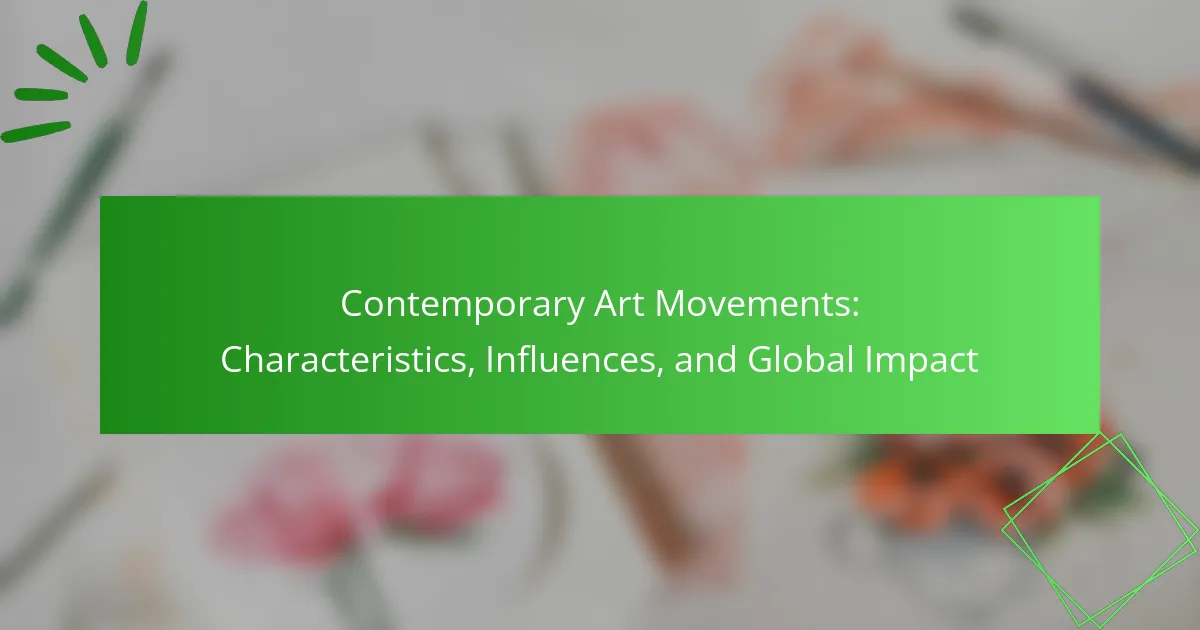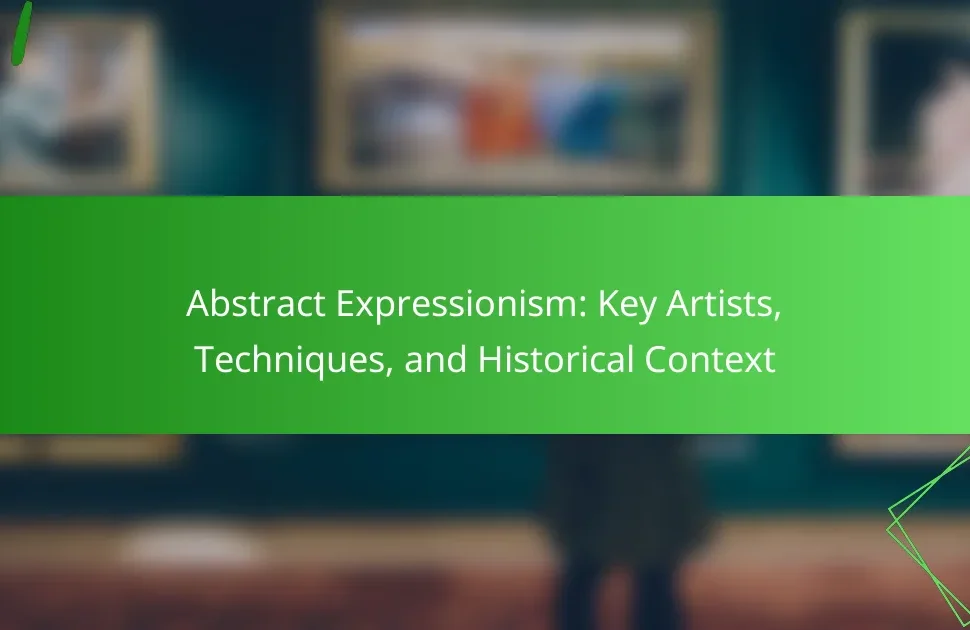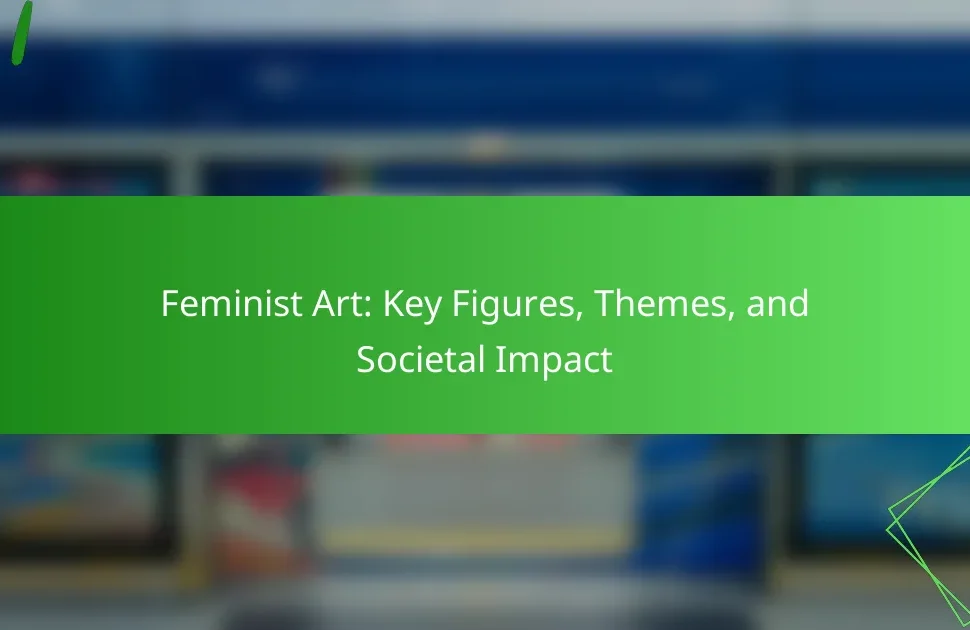Contemporary art movements play a crucial role in reflecting and shaping societal values. This article explores their key characteristics, influential figures, cultural influences, and global impact. It also examines unique attributes, regional variations, and the challenges faced by these movements today. Additionally, the significance of art fairs and exhibitions in promoting contemporary art will be discussed.
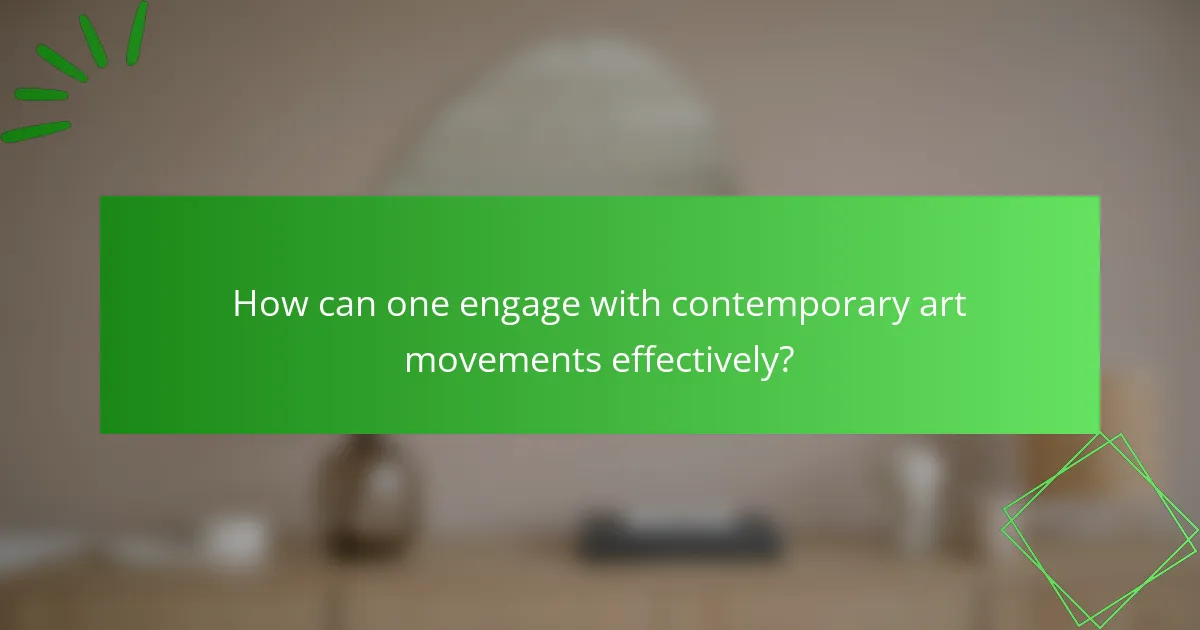
What are the defining characteristics of contemporary art movements?
Contemporary art movements are defined by their diversity, innovation, and engagement with social issues. They often challenge traditional boundaries, incorporating technology and new media. Key characteristics include a focus on individual expression, collaboration, and a global perspective. Movements like conceptual art and street art exemplify these traits, reflecting cultural dialogues and contemporary experiences. The impact of these movements is seen in their ability to provoke thought and inspire change across different societies.
How do aesthetics and themes vary across different movements?
Aesthetics and themes in contemporary art movements differ significantly based on cultural and historical contexts. For instance, minimalism emphasizes simplicity and form, while expressionism focuses on emotional experience. Additionally, postmodernism often blends styles and challenges traditional narratives, reflecting a diverse range of influences. Globalization further enriches these variations, allowing artists to draw from multiple traditions and media.
What role does technology play in shaping contemporary art?
Technology plays a crucial role in shaping contemporary art by influencing creation, distribution, and audience engagement. Digital tools enable artists to experiment with new mediums, such as virtual reality and interactive installations. These innovations expand artistic expression and challenge traditional forms. Additionally, technology facilitates global reach, allowing artists to share their work with wider audiences through online platforms. The integration of social media further enhances engagement, creating communities around contemporary art movements. This technological influence reflects a unique attribute of contemporary art, where collaboration and connectivity redefine artistic boundaries.

Which influential figures have shaped contemporary art movements?
Several influential figures have significantly shaped contemporary art movements, including Andy Warhol, Jackson Pollock, and Ai Weiwei. Andy Warhol pioneered pop art, blending commercial and fine art. Jackson Pollock’s abstract expressionism emphasized spontaneity and process. Ai Weiwei combines traditional Chinese art with social activism, challenging political norms. These artists reflect diverse ideologies and techniques, demonstrating the global impact of contemporary art.
How have artists like Banksy and Ai Weiwei impacted global perceptions?
Artists like Banksy and Ai Weiwei have significantly reshaped global perceptions of contemporary art. Their work challenges social norms and political issues, making art a platform for activism. Banksy’s street art critiques consumerism and war, while Ai Weiwei focuses on human rights and freedom of expression. Both artists utilize unique attributes, such as Banksy’s anonymity and Ai Weiwei’s multimedia approach, to engage audiences worldwide. Their influence extends beyond art, prompting discussions on cultural and political contexts, thereby enhancing the global impact of contemporary art movements.
What are the contributions of collectives and collaborations in contemporary art?
Collectives and collaborations significantly enhance contemporary art by fostering innovation, diversity, and community engagement. They allow artists to share resources and ideas, leading to unique and impactful works. Collaborative projects often address social issues, creating dialogues that resonate globally. Furthermore, these partnerships can amplify marginalized voices, enriching the art landscape with varied perspectives.
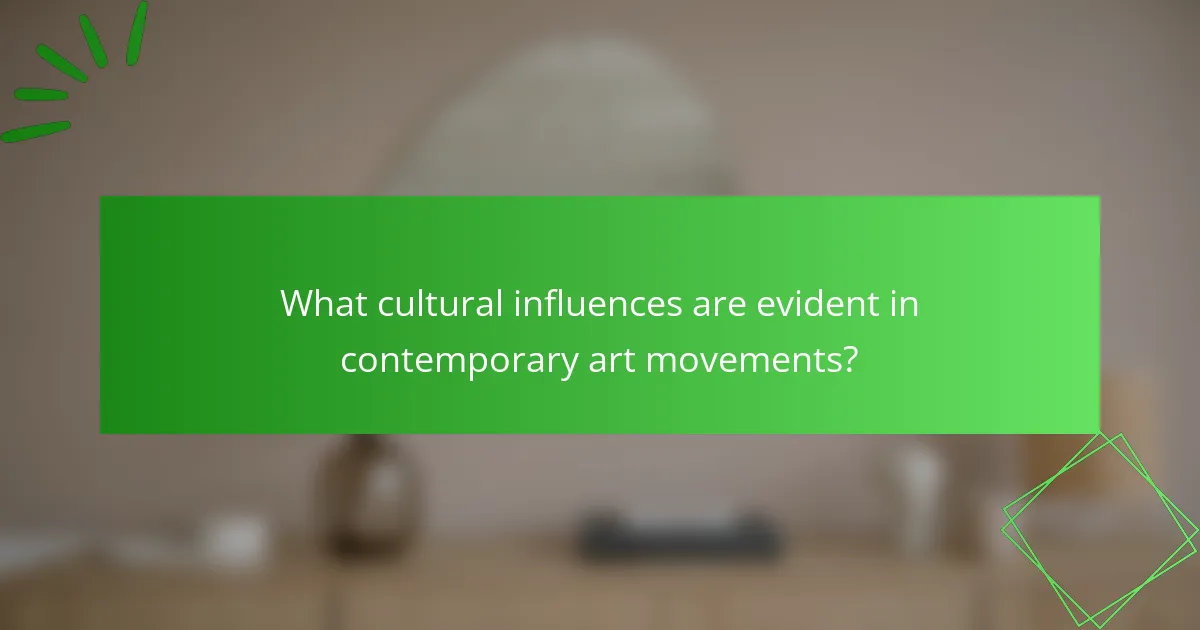
What cultural influences are evident in contemporary art movements?
Cultural influences in contemporary art movements include globalization, technology, and social issues. These factors shape artistic expression and reflect diverse perspectives. For example, the rise of digital art showcases the impact of technology, while movements like Black Lives Matter inspire works addressing racial justice. Additionally, cross-cultural exchanges enrich artistic practices, leading to hybrid styles that challenge traditional boundaries.
How do social and political contexts shape artistic expression?
Social and political contexts significantly influence artistic expression by shaping themes, styles, and mediums used by artists. Contemporary art movements often reflect societal issues, such as identity, inequality, and environmental concerns. For instance, the rise of street art has been a direct response to urban social dynamics and political unrest.
Artists frequently utilize their work to comment on current events, creating a dialogue with the public. The unique attribute of contemporary art lies in its ability to adapt and respond to global issues, making it a powerful tool for social commentary. As a result, the global impact of these movements can be seen in their ability to foster community engagement and provoke thought across diverse audiences.
Art becomes a vehicle for change, influencing public perception and encouraging activism. Thus, understanding the interplay between artistic expression and its socio-political backdrop is essential for appreciating contemporary art’s relevance and significance.
What is the significance of identity and diversity in contemporary art?
Identity and diversity are crucial in contemporary art as they reflect societal changes and foster inclusivity. Artists explore personal and collective identities, challenging norms and expanding perspectives. This movement promotes dialogue about race, gender, and culture, enhancing global understanding. Diverse expressions in art encourage innovation and resonate with broader audiences, making art more relevant today.
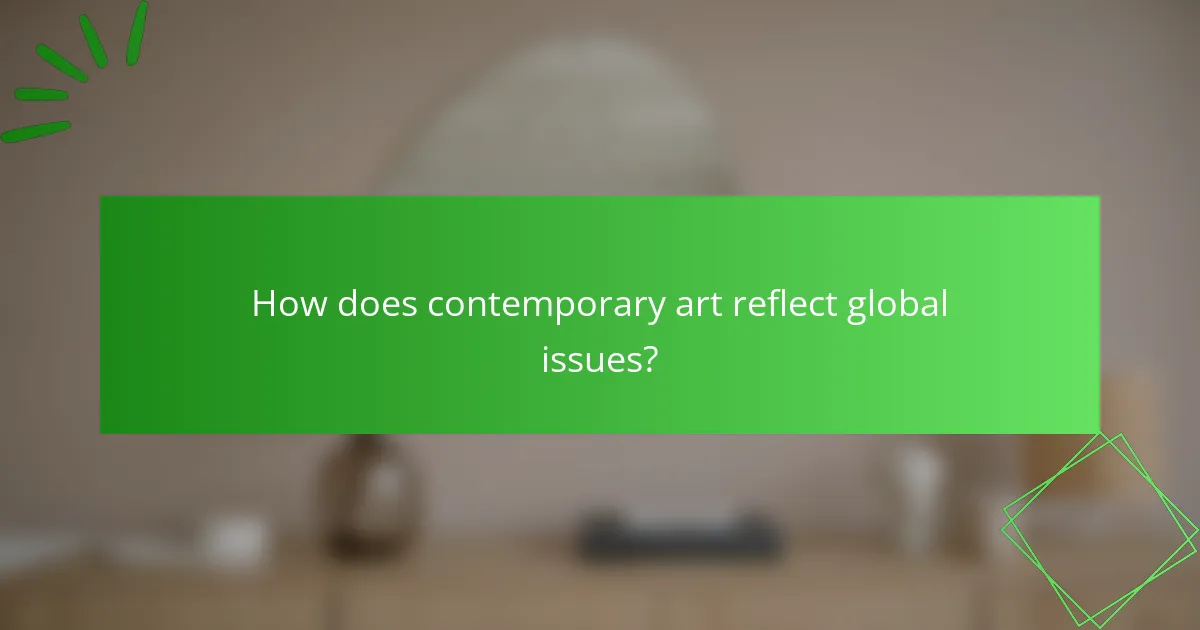
How does contemporary art reflect global issues?
Contemporary art reflects global issues by addressing social, political, and environmental challenges. Artists use diverse mediums to provoke thought and inspire action. This movement often highlights themes like inequality, climate change, and human rights, making art a powerful tool for awareness and change. For instance, street art often emerges in response to political unrest, serving as a voice for marginalized communities. Additionally, contemporary art fosters global dialogue, connecting audiences across cultures and promoting understanding.
What environmental themes are prevalent in recent artworks?
Recent artworks prominently feature environmental themes such as climate change, sustainability, and biodiversity. Artists increasingly use their platforms to address ecological issues, reflecting society’s growing awareness of environmental crises. For instance, the rise of eco-art emphasizes the relationship between nature and human activity, showcasing the impact of pollution and habitat destruction. Additionally, installations often incorporate recycled materials, promoting a message of conservation and responsible consumption. This shift in focus highlights the role of contemporary art in fostering dialogue around environmental stewardship and social responsibility.
How do contemporary artists address human rights and social justice?
Contemporary artists address human rights and social justice through activism, representation, and community engagement. They use their art to raise awareness, provoke dialogue, and inspire action on pressing societal issues. For instance, artists like Ai Weiwei and Banksy tackle themes of oppression and inequality, using public installations and street art to reach wider audiences. Their work often reflects root attributes of contemporary art movements, such as social commentary and cultural critique. Unique attributes include personal narratives and localized issues, which resonate deeply with specific communities. As a result, contemporary art becomes a powerful tool for advocacy and change.
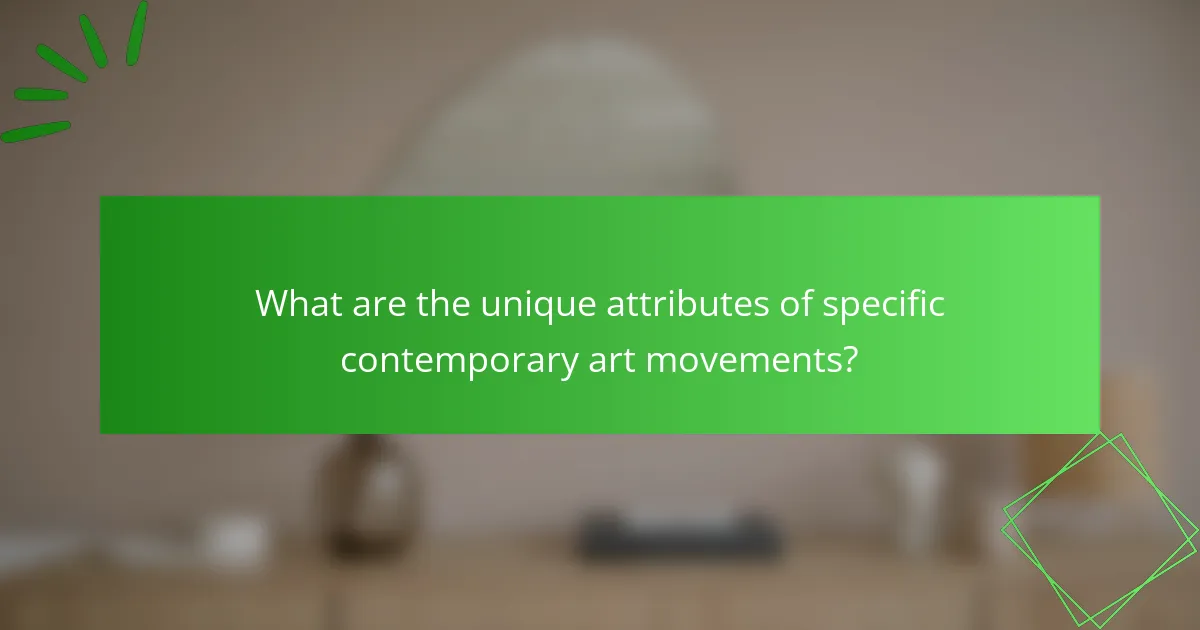
What are the unique attributes of specific contemporary art movements?
Contemporary art movements exhibit unique attributes that reflect their cultural and social contexts. These movements often challenge traditional aesthetics, embrace technology, and promote inclusivity.
One significant unique attribute is the emphasis on interactivity. Movements like Relational Aesthetics encourage viewer participation, transforming the audience into active contributors. Another unique aspect is the integration of digital media, as seen in movements such as New Media Art, which utilizes technology to create immersive experiences.
Additionally, the global perspective is a rare attribute, with movements like Global Contemporary Art highlighting diverse voices and practices from various cultures. This inclusivity contrasts with earlier art movements that often centered on Western perspectives.
These unique attributes underscore the dynamic nature of contemporary art, reflecting ongoing dialogues about identity, society, and technology.
How does street art differ from traditional gallery art?
Street art differs from traditional gallery art by its accessibility and public nature. Street art is often created in urban spaces, making it available to a broader audience without the barriers of entry found in galleries. In contrast, traditional gallery art is typically displayed in controlled environments, catering to specific demographics.
Street art reflects social and political themes, engaging communities directly. Artists often use unconventional materials and techniques, enhancing the uniqueness of each piece. Traditional gallery art usually adheres to established norms and practices, focusing on aesthetic value and artistic technique.
Moreover, street art can be ephemeral, subject to removal or alteration, while gallery art often aims for permanence through conservation. This dynamic nature of street art contributes to its cultural relevance and impact, contrasting with the more static presentation of traditional art forms.
What distinguishes digital art from other contemporary forms?
Digital art is distinguished by its use of digital technology as a primary medium. Unlike traditional forms, it allows for unique attributes such as interactivity and infinite reproducibility. Digital art can incorporate various influences from contemporary movements, blending techniques and styles. The global impact of digital art is evident in its accessibility and ability to reach diverse audiences, reshaping the art landscape.
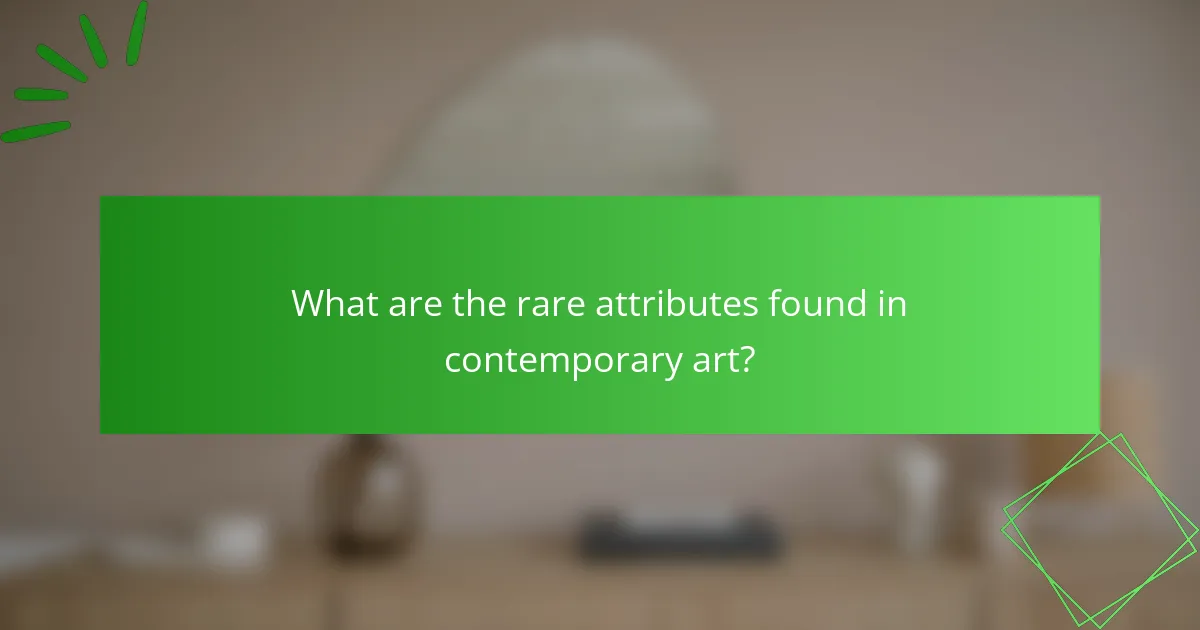
What are the rare attributes found in contemporary art?
Contemporary art features rare attributes that distinguish it from traditional forms. These include the use of unconventional materials, interactive installations, and the integration of technology. Artists often challenge societal norms, exploring themes like identity, globalization, and environmental issues. Additionally, the ephemeral nature of some works, such as performance art or site-specific installations, adds to their uniqueness.
How do ephemeral art installations challenge conventional permanence?
Ephemeral art installations challenge conventional permanence by emphasizing transience and viewer engagement. These works often exist only for a limited time, prompting audiences to reflect on the nature of art and its relationship to memory. This temporary aspect encourages participation and interaction, fostering a deeper connection between the artwork and its audience. As a result, ephemeral art can provoke critical discussions about the value of permanence in art versus the significance of experience. Notably, artists like Christo and Jeanne-Claude have exemplified this movement, creating large-scale installations that are dismantled shortly after completion, highlighting the fleeting nature of beauty and meaning.
What is the impact of performance art on audience engagement?
Performance art significantly enhances audience engagement by fostering emotional connections and active participation. This art form encourages viewers to experience the work in real-time, creating a shared moment that deepens their involvement.
The interactive nature of performance art often blurs the line between artist and audience, inviting spectators to reflect on their own experiences and emotions. As a result, this engagement can lead to a transformative experience, promoting dialogue and community building.
Moreover, performance art can challenge societal norms, prompting audiences to confront uncomfortable truths. This provocation can lead to heightened awareness and critical thinking, further enriching the engagement process.
In contemporary art movements, performance art serves as a unique attribute that distinguishes itself from traditional visual arts, emphasizing the importance of the ephemeral experience.
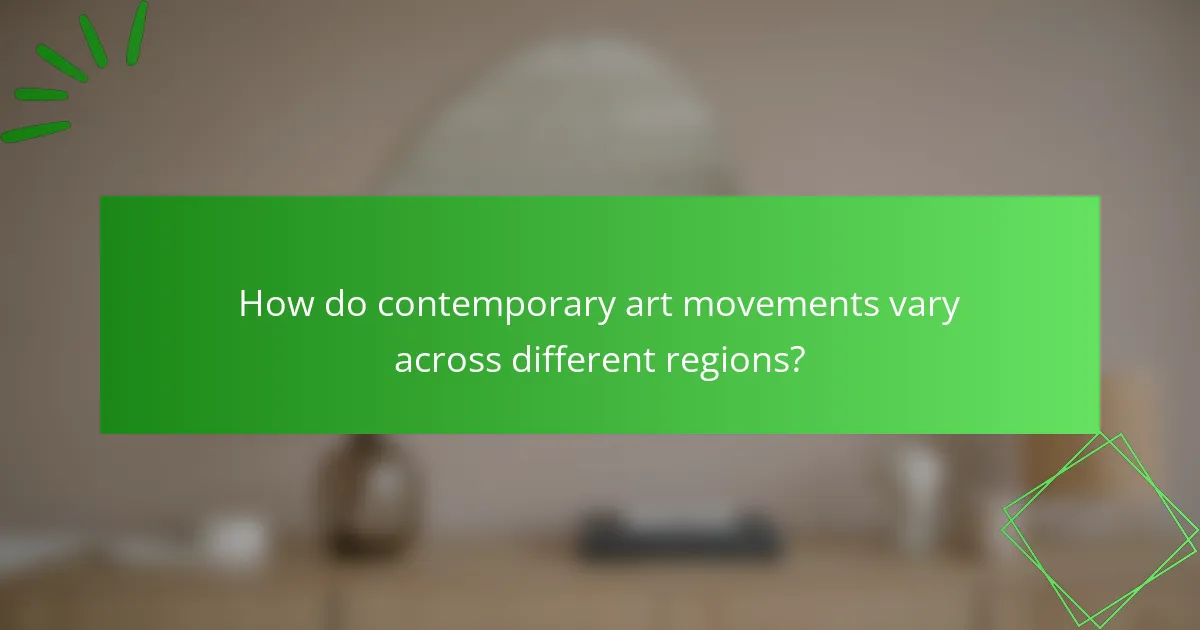
How do contemporary art movements vary across different regions?
Contemporary art movements vary significantly across regions due to cultural influences and historical contexts. In Europe, movements like Abstract Expressionism and Minimalism emerged, emphasizing individual expression and simplicity. In Asia, contemporary art often integrates traditional practices with modern themes, reflecting a unique blend of heritage and innovation. African contemporary art frequently addresses social and political issues, utilizing vibrant colors and local materials. Latin American movements showcase a rich tapestry of indigenous influences and contemporary techniques, often focusing on identity and community. Each region’s distinct characteristics contribute to the global art landscape, showcasing diversity and innovation.
What are the unique trends in contemporary art in Europe?
Unique trends in contemporary art in Europe include a focus on sustainability, digital integration, and social activism. Artists increasingly address climate change, using eco-friendly materials and practices. Digital art forms, such as NFTs, are gaining traction, reflecting technological advancements. Socially engaged art promotes dialogue on issues like inequality and identity. These trends highlight the evolving relationship between art and society.
How does the contemporary art scene in Asia differ from Western perspectives?
The contemporary art scene in Asia emphasizes diverse cultural narratives, contrasting with Western perspectives that often prioritize individualism. Asian movements frequently incorporate traditional elements, reflecting communal values and historical contexts. For instance, the influence of spirituality and social commentary is prevalent in many Asian artworks. This contrasts with the Western focus on abstraction and personal expression. Additionally, the rapid globalization of the art market has led to a unique fusion of styles in Asia, showcasing a blend of modern techniques with cultural heritage.
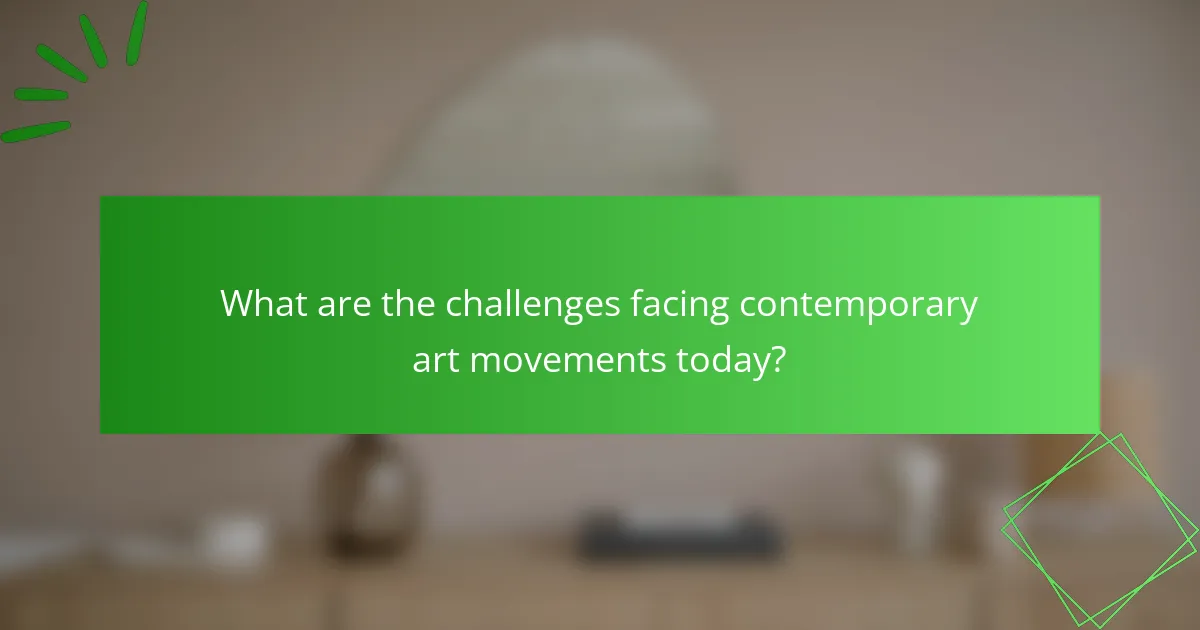
What are the challenges facing contemporary art movements today?
Contemporary art movements face several challenges today, including commercialization, cultural appropriation, and the impact of digital technology. These factors can dilute artistic authenticity and hinder the exploration of new ideas.
The commercialization of art often prioritizes marketability over creativity, leading to a focus on what sells rather than on innovative or challenging works. Cultural appropriation raises ethical concerns, as artists navigate the complexities of borrowing from diverse cultures without proper context or respect.
Digital technology presents both opportunities and obstacles. While it enables wider dissemination and new forms of expression, it can also lead to oversaturation and a lack of depth in artistic engagement.
These challenges necessitate a critical examination of the values and practices within contemporary art movements, pushing artists to find unique voices amid these pressures.
How does funding and support influence artistic freedom?
Funding and support significantly enhance artistic freedom by providing resources and opportunities. Financial backing allows artists to explore innovative ideas without commercial constraints. Support from institutions fosters diverse expressions and encourages experimentation. Global art movements thrive when artists access grants, residencies, and collaborative projects, promoting cultural exchange and creativity.
What are the implications of commercialization in contemporary art?
Commercialization in contemporary art leads to both opportunities and challenges. It can enhance visibility and financial support for artists but risks diluting artistic integrity. Increased market demand may prioritize commercial viability over experimental practices. The influence of collectors and galleries can shape artistic direction, often favoring trends. This dynamic raises questions about authenticity and the role of art in society.
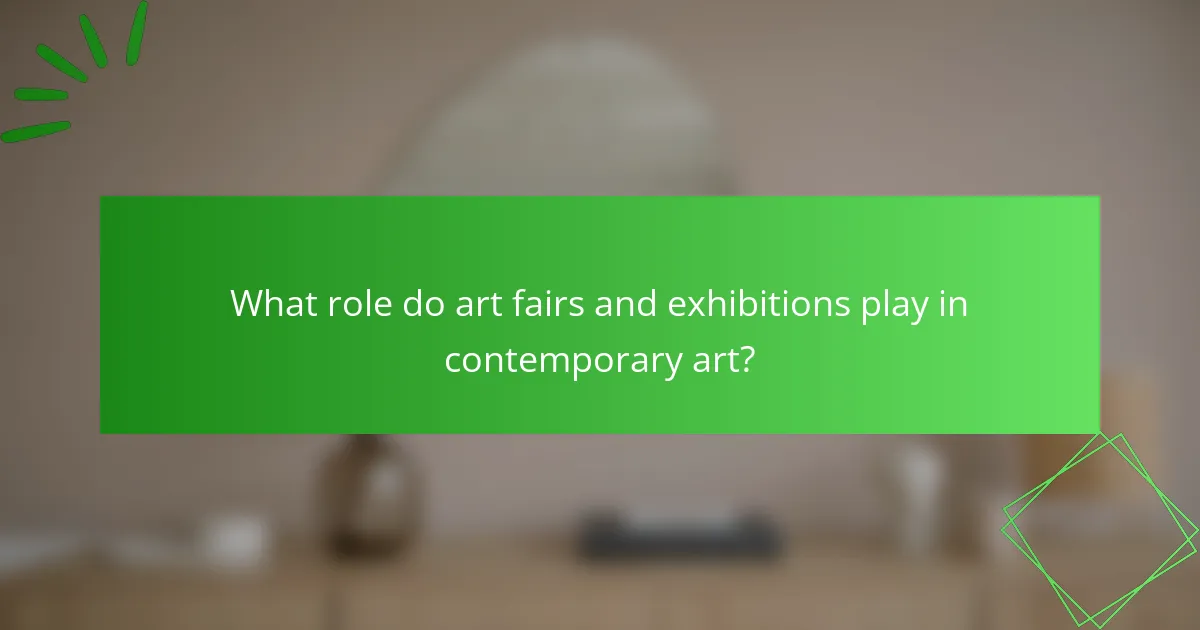
What role do art fairs and exhibitions play in contemporary art?
Art fairs and exhibitions play a crucial role in contemporary art by providing platforms for artists to showcase their work. They facilitate connections between artists, collectors, and the public, enhancing visibility and opportunities for emerging talents.
These events often reflect current trends and movements in contemporary art, influencing market dynamics and cultural discourse. For example, major art fairs like Art Basel and Frieze have become essential for understanding global art trends, showcasing diverse practices and fostering international dialogue.
Additionally, art fairs and exhibitions can significantly impact an artist’s career trajectory. Participation can lead to increased sales, gallery representation, and critical recognition. The unique attribute of these events lies in their ability to create a shared space for artistic exchange, which can elevate lesser-known artists to prominence.
As a result, art fairs and exhibitions not only contribute to the economic aspects of the art market but also shape the cultural landscape of contemporary art, making them vital components of the ecosystem.
How do international events like Art Basel shape market trends?
International events like Art Basel significantly influence market trends by showcasing emerging artists and new works. These events create a platform for networking, sales, and establishing value in contemporary art. As a result, galleries and collectors adjust their strategies based on trends observed during these exhibitions. The visibility provided by Art Basel often leads to increased demand for featured artists, impacting pricing and investment in the art market.
What is the significance of local galleries in promoting emerging artists?
Local galleries play a crucial role in promoting emerging artists by providing them with exposure and opportunities. These spaces often serve as platforms for new talent to showcase their work, fostering community engagement and artistic dialogue. By hosting exhibitions and events, local galleries connect artists with potential buyers and art enthusiasts, enhancing their visibility. Additionally, galleries often curate diverse shows that reflect contemporary art movements, influencing public perception and appreciation of emerging artists. This support can significantly impact an artist’s career trajectory and contribute to the overall vibrancy of the local art scene.

How can one engage with contemporary art movements effectively?
Engaging with contemporary art movements effectively requires active participation and open-mindedness. Attend exhibitions and gallery openings to immerse yourself in the art community. Follow artists and critics on social media to stay updated on trends and discussions. Participate in workshops or classes to gain hands-on experience and insights. Collaborate with local art groups to foster connections and share perspectives. Lastly, engage in critical discussions to deepen your understanding and appreciation of contemporary art’s diverse influences and impacts.
What are best practices for appreciating and understanding contemporary art?
To appreciate and understand contemporary art, engage actively with the artwork, considering its context and the artist’s intent. Explore various movements like minimalism or conceptual art, which emphasize different characteristics. Attend exhibitions and discussions to gain insights into global influences. Analyze the interplay of culture and technology in shaping contemporary expressions, as these aspects significantly impact interpretation. Finally, maintain an open mind, allowing personal experiences to inform your perspective.
How can collectors and enthusiasts support artists and movements?
Collectors and enthusiasts can support artists and movements by purchasing artwork, promoting exhibitions, and engaging in community events. Their financial contributions directly empower artists to create and innovate. Additionally, sharing artists’ work on social media enhances visibility and fosters connections within the art community. Supporting local galleries and art fairs strengthens the infrastructure for contemporary art movements. Engaging in discussions about art can also raise awareness and appreciation, driving broader interest and support for diverse artistic expressions.
